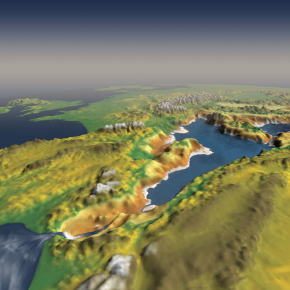
How 70% of the Mediterranean Sea was lost 5.5 million years ago
A new study, led by a CNRS researcher1
, has highlighted just how significantly the level of the Mediterranean Sea dropped during the Messinian Salinity Crisis – a major geological event that transformed the Mediterranean into a gigantic salt basin between 5.97 and 5.33 million years ago2
.
Until now, the process by which a million cubic kilometres of salt accumulated in the Mediterranean basin over such a short period of time remained unknown. Thanks to analysis of the chlorine isotopes3
contained in salt extracted from the Mediterranean seabed, scientists have been able to identify the two phases of this extreme evaporation event. During the first phase, lasting approximately 35 thousand years, salt deposition occurred only in the eastern Mediterranean, triggered by the restriction of Mediterranean outflow to the Atlantic, in an otherwise brine-filled Mediterranean basin. During the second phase, salt accumulation occurred across the entire Mediterranean, driven by a rapid (< 10 thousand years) evaporative drawdown event during which sea-level dropped 1.7-2.1 km and ~0.85 km in the eastern and western Mediterranean, respectively. As a result, the Mediterranean Basin lost up to 70% of its water volume.
This spectacular fall in sea level is thought to have had consequences for both terrestrial fauna and the Mediterranean landscape – triggering localised volcanic eruptions due to unloading of Earth's crust, as well as generating global climatic effects due to the huge depression caused by the sea-level drawdown.
These results, published in Nature Communications on November 18, provide a better understanding of past extreme geological phenomena, the evolution of the Mediterranean region and successive global repercussions.
This work was supported by the European Union and the CNRS.


Chlorine isotopes constrain a major drawdown of the Mediterranean Sea during the Messinian Salinity Crisis. G. Aloisi, J. Moneron, L. Guibourdenche, A. Camerlenghi, I. Gavrieli, G. Bardoux, P. Agrinier, R. Ebner et Z. Gvirtzman. Nature Communications, November 18, 2024.
DOI : 10.1038/s41467-024-53781-6
Contact
Notes
- From the French research institute Institut de physique du globe de Paris (CNRS/Université Paris Cité/Institut de physique du globe de Paris).
- This exceptional event covered the floor of the Mediterranean Sea with a layer of salt up to 3 km thick. Understanding the causes, consequences and environmental changes undergone by the Mediterranean region in response to the Messinian Salinity Crisis is a challenge that has mobilised the scientific community for decades.
- Analysis of the two stable chlorine isotopes (³⁷Cl and ³⁵Cl) made it possible to estimate the rate of salt accumulation and detect the drop in sea level.


